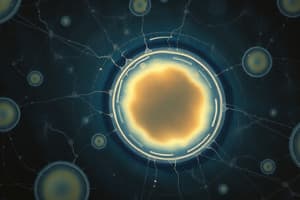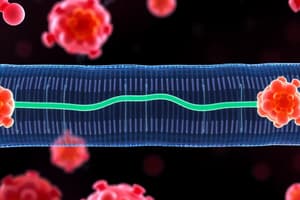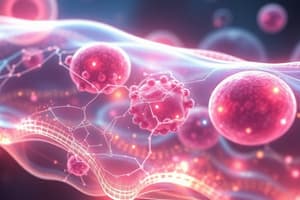Podcast
Questions and Answers
What is the primary role of the plasma membrane in a living cell?
What is the primary role of the plasma membrane in a living cell?
- Regulating the movement of substances into and out of the cell (correct)
- Synthesizing proteins needed for metabolism
- Storing genetic information
- Generating energy for cellular processes
In the fluid mosaic model of the plasma membrane, what is responsible for the 'fluid' characteristic?
In the fluid mosaic model of the plasma membrane, what is responsible for the 'fluid' characteristic?
- Fixed positioning of glycoproteins and glycolipids
- Rigid structure provided by cholesterol molecules
- Dynamic and flexible structure formed by phospholipids, proteins, and cholesterols (correct)
- Static arrangement of protein molecules within the phospholipid bilayer
Which component of the plasma membrane is responsible for stabilizing the membrane by forming hydrogen bonds with water?
Which component of the plasma membrane is responsible for stabilizing the membrane by forming hydrogen bonds with water?
- Carrier proteins
- Channel proteins
- Glycoproteins and glycolipids (correct)
- Cholesterol molecules
Which of the following best describes the orientation of the phospholipid molecules in the membrane?
Which of the following best describes the orientation of the phospholipid molecules in the membrane?
What role do cholesterol molecules play in the plasma membrane?
What role do cholesterol molecules play in the plasma membrane?
Which factor does NOT contribute to the 'mosaic' characteristic of the plasma membrane?
Which factor does NOT contribute to the 'mosaic' characteristic of the plasma membrane?
What defines the proteins that function as channels in the plasma membrane?
What defines the proteins that function as channels in the plasma membrane?
Which molecule is NOT correctly matched with its function in the plasma membrane?
Which molecule is NOT correctly matched with its function in the plasma membrane?
The movement of substances into and out of the cell is regulated by the ______.
The movement of substances into and out of the cell is regulated by the ______.
According to the fluid mosaic model, protein molecules float within the ______, forming a mosaic pattern that changes frequently.
According to the fluid mosaic model, protein molecules float within the ______, forming a mosaic pattern that changes frequently.
A polar head which is hydrophilic is attracted to ______.
A polar head which is hydrophilic is attracted to ______.
The protein molecules with channels or canals are known as ______ proteins.
The protein molecules with channels or canals are known as ______ proteins.
Some proteins and lipids have carbohydrate chains attached to them, known as ______ and glycolipid respectively.
Some proteins and lipids have carbohydrate chains attached to them, known as ______ and glycolipid respectively.
The protein molecules that function as carriers are called ______ proteins.
The protein molecules that function as carriers are called ______ proteins.
Cholesterols make the phospholipid bilayer stronger, more flexible and less permeable to ______-soluble substances such as ions.
Cholesterols make the phospholipid bilayer stronger, more flexible and less permeable to ______-soluble substances such as ions.
The ______ characteristic of the plasma membrane makes it more flexible.
The ______ characteristic of the plasma membrane makes it more flexible.
Study Notes
Necessity of Movement of Substances across Plasma Membrane
- Living cells require substances from external environment for living processes
- Metabolic processes produce waste that needs to be disposed of
- Cells must allow substances to move into and out of cells to maintain living processes
- Plasma membrane regulates movement of substances
Structure of Plasma Membrane
- Plasma membrane is a thin layer that separates cell from its environment
- Consists of phospholipid bilayer with protein molecules embedded within
- Phospholipid molecules have:
- Hydrophilic (attracted to water) polar head
- Hydrophobic (repels water) nonpolar tail
- Phospholipid heads in outer layer face extracellular fluid, while heads in inner layer face cytoplasm
- Phospholipid tails in both layers face each other
- Protein molecules are embedded partially or fully within the membrane
- Protein molecules are:
- Channel proteins with channels or canals
- Carrier proteins that function as carriers
- Glycoprotein and glycolipid have carbohydrate chains attached
- Glycoprotein and glycolipid act as:
- Receptors to hormones like insulin
- Stabilizers of membrane by forming hydrogen bonds with water
- Antigens for cell identification
- Cholesterol molecules make phospholipid bilayer:
- Stronger
- More flexible
- Less permeable to water-soluble substances like ions
- Plasma membrane structure is dynamic and flexible
Necessity of Movement of Substances across Plasma Membrane
- Living cells require substances from external environment for living processes
- Metabolic processes produce waste that needs to be disposed of
- Cells must allow substances to move into and out of cells to maintain living processes
- Plasma membrane regulates movement of substances
Structure of Plasma Membrane
- Plasma membrane is a thin layer that separates cell from its environment
- Consists of phospholipid bilayer with protein molecules embedded within
- Phospholipid molecules have:
- Hydrophilic (attracted to water) polar head
- Hydrophobic (repels water) nonpolar tail
- Phospholipid heads in outer layer face extracellular fluid, while heads in inner layer face cytoplasm
- Phospholipid tails in both layers face each other
- Protein molecules are embedded partially or fully within the membrane
- Protein molecules are:
- Channel proteins with channels or canals
- Carrier proteins that function as carriers
- Glycoprotein and glycolipid have carbohydrate chains attached
- Glycoprotein and glycolipid act as:
- Receptors to hormones like insulin
- Stabilizers of membrane by forming hydrogen bonds with water
- Antigens for cell identification
- Cholesterol molecules make phospholipid bilayer:
- Stronger
- More flexible
- Less permeable to water-soluble substances like ions
- Plasma membrane structure is dynamic and flexible
Studying That Suits You
Use AI to generate personalized quizzes and flashcards to suit your learning preferences.
Description
Learn about the structure and function of the plasma membrane in cells, including the movement of substances across it. Understand why cells need to regulate what enters and leaves the cell to maintain life processes.




